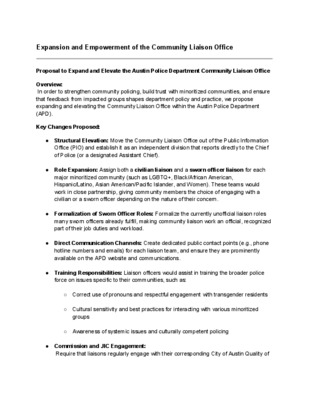Item 11 - Draft Recommendation on APD Community Liaison — original pdf
Backup

Expansion and Empowerment of the Community Liaison Office Proposal to Expand and Elevate the Austin Police Department Community Liaison Office Overview: In order to strengthen community policing, build trust with minoritized communities, and ensure that feedback from impacted groups shapes department policy and practice, we propose expanding and elevating the Community Liaison Office within the Austin Police Department (APD). Key Changes Proposed: ● Structural Elevation: Move the Community Liaison Office out of the Public Information Office (PIO) and establish it as an independent division that reports directly to the Chief of Police (or a designated Assistant Chief). ● Role Expansion: Assign both a civilian liaison and a sworn officer liaison for each major minoritized community (such as LGBTQ+, Black/African American, Hispanic/Latino, Asian American/Pacific Islander, and Women). These teams would work in close partnership, giving community members the choice of engaging with a civilian or a sworn officer depending on the nature of their concern. ● Formalization of Sworn Officer Roles: Formalize the currently unofficial liaison roles many sworn officers already fulfill, making community liaison work an official, recognized part of their job duties and workload. ● Direct Communication Channels: Create dedicated public contact points (e.g., phone hotline numbers and emails) for each liaison team, and ensure they are prominently available on the APD website and communications. ● Training Responsibilities: Liaison officers would assist in training the broader police force on issues specific to their communities, such as: ○ Correct use of pronouns and respectful engagement with transgender residents ○ Cultural sensitivity and best practices for interacting with various minoritized groups ○ Awareness of systemic issues and culturally competent policing ● Commission and JIC Engagement: Require that liaisons regularly engage with their corresponding City of Austin Quality of Life Commissions (e.g., the Asian American QOL Commission, the LGBTQIA+ Commission) and provide updates and receive input. The liaisons should act as bridges between community representation bodies and APD leadership. ● Policy Feedback Role: Empower liaison teams to provide policy recommendations to APD leadership informed by the needs of their respective communities, ensuring direct integration of lived experiences into policing policy. Goals of This Proposal: ● Create more accessible, transparent, and culturally competent channels for communication between APD and minoritized communities. ● Ensure that community voices—especially those represented by the city's various commissions and the Joint Inclusion Committee (JIC)—are actively heard and integrated into APD policies and practices. ● Build lasting trust by empowering both civilian and officer representatives to act quickly on concerns, de-escalate tensions, and address issues early. ● Formalize the critical community work already being done by some officers, providing structure, resources, and accountability. ● Improve internal APD culture by delivering regular, peer-to-peer community training led by liaison officers familiar with the needs of specific groups. ● Make policing in Austin more community-driven, preventative, and equitable. Updated Feasibility Study Request: City Manager Request for Feasibility Study Request for Feasibility Study: Community Liaison Office Expansion and Empowerment Purpose of Study: To assess the operational, budgetary, and organizational feasibility of expanding and elevating the Community Liaison Office as outlined in the attached proposal. Scope of the Study Should Include: ● Structural recommendations for moving the Community Liaison Office under the Chief of Police's direct authority. ● Staffing model development to assign a civilian liaison and a sworn officer liaison for each major minoritized community. ● Timeline and budget estimates for hiring, training, and public communications needs (including hotlines and website updates). ● Recommendations for formalizing liaison responsibilities within the sworn officers' official job descriptions. ● Development of a communication and accountability framework for regular engagement between liaisons and City Commissions/Joint Inclusion Committee (JIC). ● Examples of best practices from peer cities. ● Drafting of performance metrics and training frameworks for liaison roles. Deliverable: A written report and recommended phased implementation plan delivered to the City Manager's Office within six months, for further evaluation by APD leadership, City Council, and relevant commissions. Expansion and Empowerment of the Austin Police Department Community Liaison Office Background: The Austin Police Department currently relies solely on civilian staff for its Community Liaison Office under the Public Information Office. While some sworn officers informally act as liaisons, these efforts are not formalized, resourced, or structured. Proposal Highlights: ● Move the Community Liaison Office to report directly to the Chief of Police. ● Assign both a civilian liaison and a sworn officer liaison to each minoritized community. ● Create direct, public-facing communication channels (hotlines/emails) for each community team. ● Empower liaisons to: ○ Provide direct policy feedback to APD leadership ○ Engage regularly with their corresponding City Commissions and the Joint Inclusion Committee (JIC) ○ Conduct specialized cultural training for the rest of the police force Goals: ● Strengthen trust and transparency between APD and communities most impacted by policing ● Create more accessible and culturally competent engagement pathway ● Formalize and professionalize liaison roles among sworn officers Improve APD’s internal practices through community-driven training and feedback ● ● Address concerns about policing with real structural reforms that center community needs Next Step: Request a City Manager-led Feasibility Study to design the expansion plan and recommend phased implementation strategies.